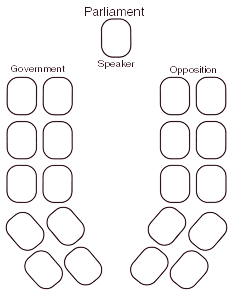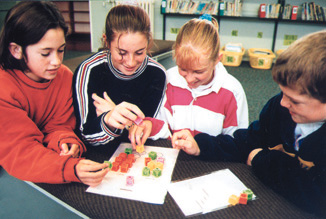|
:
Parliament
|
|
%
responses
|
|||
|
y8
|
|||
|
Government |
good
moderate poor |
15
29 56 |
|
|
Prime Minister |
good
moderate poor |
17
50 33 |
|
|
Opposition |
good
moderate poor |
7
26 67 |
|
| Leader of the Opposition |
good
moderate poor |
14
32 54 |
|
| Ministers |
good
moderate poor |
12
35 53 |
|
| Speaker of the House |
good
moderate poor |
13
12 75 |
|
| Members of Parliament |
good
moderate poor |
19
23 58 |
|
| Coalition Parties |
good
moderate poor |
29
26 45 |
|
|
|
|||
| Place the parliament chart and coloured blocks in front of the students. | |||
|
I want you to imagine
that each of these blocks represents a member of parliament. There are 4 different
colours for 4 different parties. For example, the yellow cubes are for the Yellow
Party; the
pink cubes are for the Pink Party. We will always call the parties by those names
- we won't use words like "National Party" or "Labour Party".
We will imagine that each of you is the leader of one of these parties, and therefore one of the cubes is you! Remember, this is not real life, so don't worry if you haven't got the most members. To stay as the government means you have to get more than half of the votes on important decisions. Each member has only one vote. This chart shows a plan of a large room where all of the members of parliament meet to their do their business and have their debates. There are enough seats for each member of parliament. I want you to arrange the "members of parliament" so that each one has a seat. The way you seat them should be like the way they are seated in their parties in a real parliament. You will need to decide which parties will be the government. Do that now, and I'll ask you to explain your arrangement when it is done. Allow time for
students to arrange the "members". What makes those parties the government? Students give their
explanation. Now explain to me
what you have done, and which parties are the government. Now I want you to
imagine that the Orange Party thinks a law should be passed that says children
should only go to school if they want to. Allow 3 minutes
for discussion. |
|
%
responses |
||
|
y8 |
||
|
Explanation
of how to get numbers to form a government:
very good |
5 20 28 47 |
|
|
Explanation
of how seating would be arranged: very
good |
6 11 28 55 |
|
|
Explanation
of how laws are passed: very
good |
0 12 27 61 |
|
|
Commentary: |
||
| [ top of the page | Social Studies Report 1997 ] | ||

